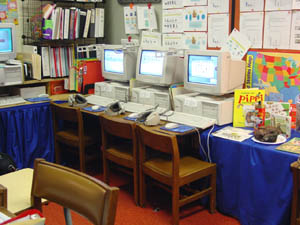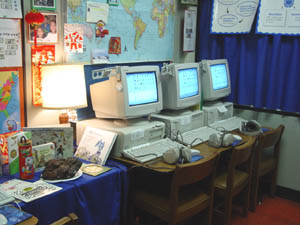|
Learning in Teams
|
|
 |
 |
|
Six students at a time come to my computer lab for extra help in math, reading and language arts. They are in my lab for approximately 25 minutes each day. You can see from the pictures that our "landscape" divides our group automatically. My six students can work in teams of three students each. We don't really have a choice! I generally try to put a boy between two girls or a girl between two boys. In each of my classes I have a mixture of race, gender and ability and can divide the small group into two parts that are a nice blend of each.
Forming Teams How might one organize students into groups in a typical classroom? What roles or responsibilities might students have? What self- monitoring techniques can be especially effective? Students should be organized into heterogeneous groups so that each of the groups within the class have an equal balance. I think that teachers should choose the groups to make sure that gender, ability and personalities are spread equally across the groups. Students can be part of the goal setting process so that they assume ownership of the team project. They can establish the tasks that must be completed, monitor their team process, evaluate their progress during their group work and also the final product. Each student can be responsible for self-monitoring as well as monitoring the group’s work as a whole.
Team Roles Within the cooperative groups students can assume such roles as:
Self monitoring techniques:
I like checklists for monitoring student progress. The checklist should have columns for the student’s name, assigned tasks, comments, date due and date completed. There could also be a column for a HOT evaluation.
H - High Performing The check list is not something for the end of the project but instead is used during the entire group process. Project Idea for Teamwork The Kidlink Day project is a favorite project of mine that is excellent to use with small groups. I have included a lesson plan for extending the activities of this project. The lesson plan includes suggestions for team work and self evaluations. Additional resources for that project are also found here: |
|
|
|
|
| home | greetings | new | kids | teachers | visitors | resources |
Patti Weeg |